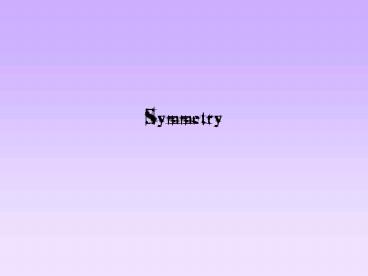Symmetry - PowerPoint PPT Presentation
1 / 10
Title:
Symmetry
Description:
We will use this idea to study the symmetry of two-dimensional objects. ... A rigid motion moves every point in the plane from its starting position to an ... – PowerPoint PPT presentation
Number of Views:65
Avg rating:3.0/5.0
Title: Symmetry
1
Symmetry
2
What is Symmetry?
- The word symmetry comes from Greek and means of
like measure. - It conveys the idea of correspondence,
equivalence, or balance. - Many people think of symmetry in terms of
reflection. - But there is much more to symmetry than that.
3
Understanding Symmetry
- Consider the objects below.
- Which would you describe as having the most
symmetry? - The least?
A
B
B
A
A
B
C
D
C
D
A
B
C
D
D
C
4
Describing Symmetry
- We say that an object has symmetry if it looks
the same from two or more different vantage
points. - Another way of looking at this is if we can move
the object so that it looks exactly the same. - We will use this idea to study the symmetry of
two-dimensional objects. - So lets study how we can move objects.
5
Rigid Motions
- A rigid motion is the act of moving an object
without changing its shape or size. - Under a rigid motion a circle is still a circle,
a square is still a square, and the dimensions
remain the same. - The distance between two points will stay the
same.
A rigid motion.
Not a rigid motion.
6
Equivalent Rigid Motions
- When studying rigid motions we are not concerned
as much with what happens in the process as the
end result. - If the end result of two different rigid motions
is the same, we say these motions are equivalent.
- In the plane, all rigid motions are equivalent to
one of four basic types - reflection
- rotation
- translation
- glide reflection
7
Studying Rigid Motions
- A rigid motion moves every point in the plane
from its starting position to an ending position.
- If we call the starting point P, we will call the
ending point P'. - If P and P' are the same point (i.e. P is not
really moved), we call P a fixed point of the
motion. - Since a rigid motion does not change shapes,
distances or angles, we can understand the effect
of a rigid motion by knowing how it affects only
a few points.
8
Reflections
Reflections
9
Reflections
- A reflection creates a mirror image of the
original object. - A reflection moves every point an equal distance
to the other side of a given line, called the
axis of reflection.
A
A'
B
B'
C
C'
10
Reflections
- To understand a reflection, all we need to know
is how it moves one point P. - Every point is reflected perpendicular to the
axis of reflection and is moved to equal distance
on the other side of the axis. - That is, the distances from the axis of
reflection to P and P' are the same. - And the axis of reflection is perpendicular to
the line joining these two points.
P'
P































